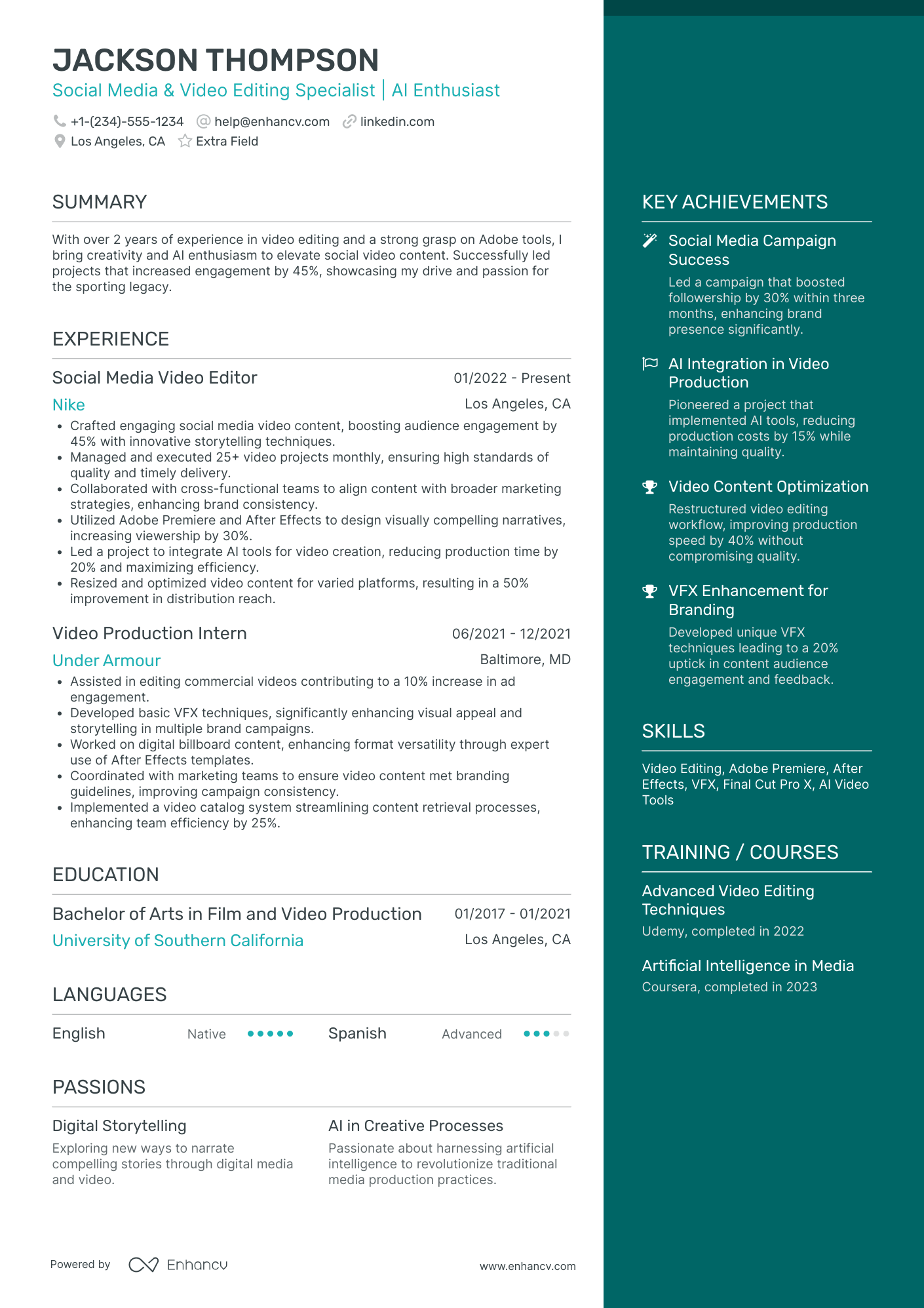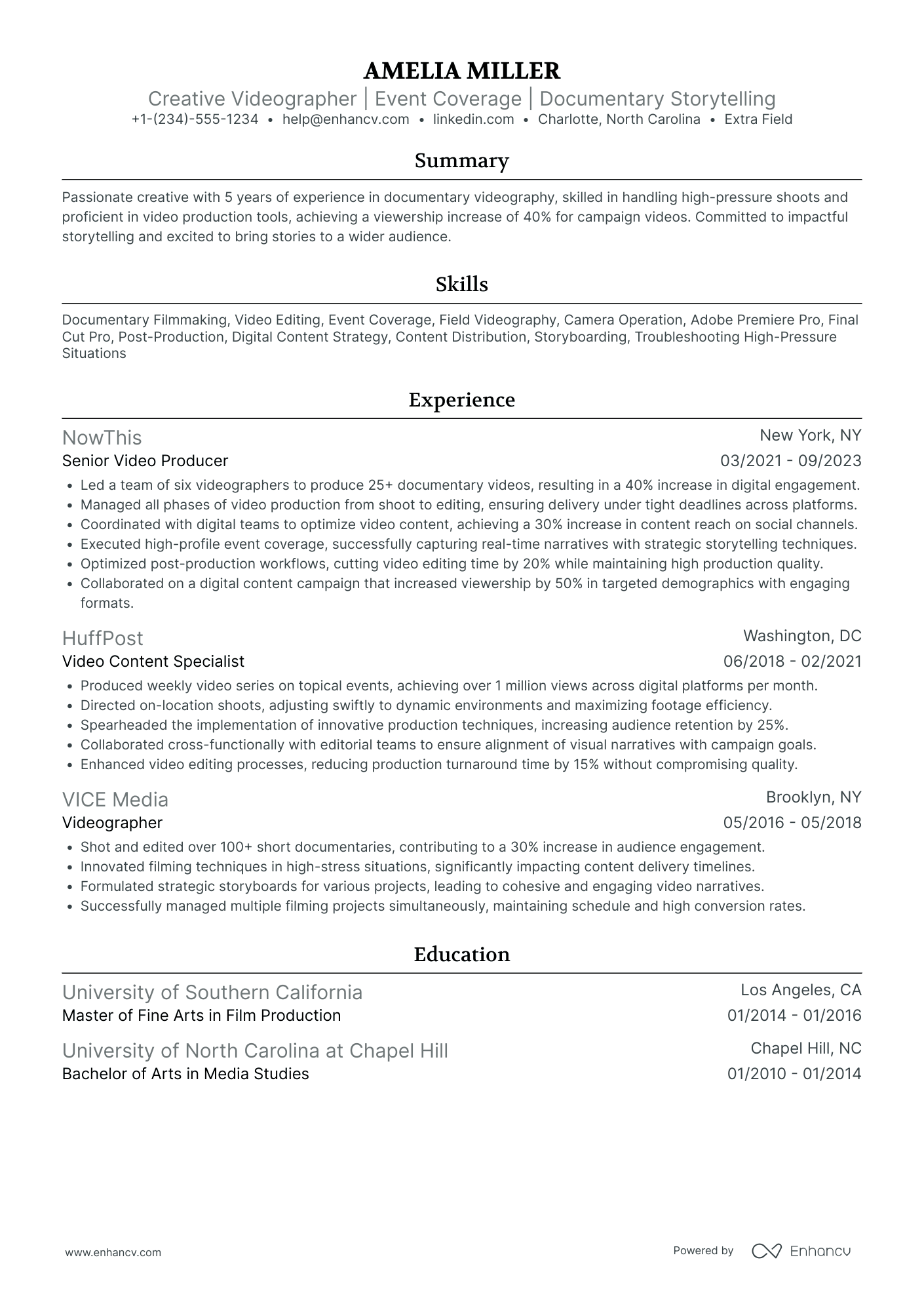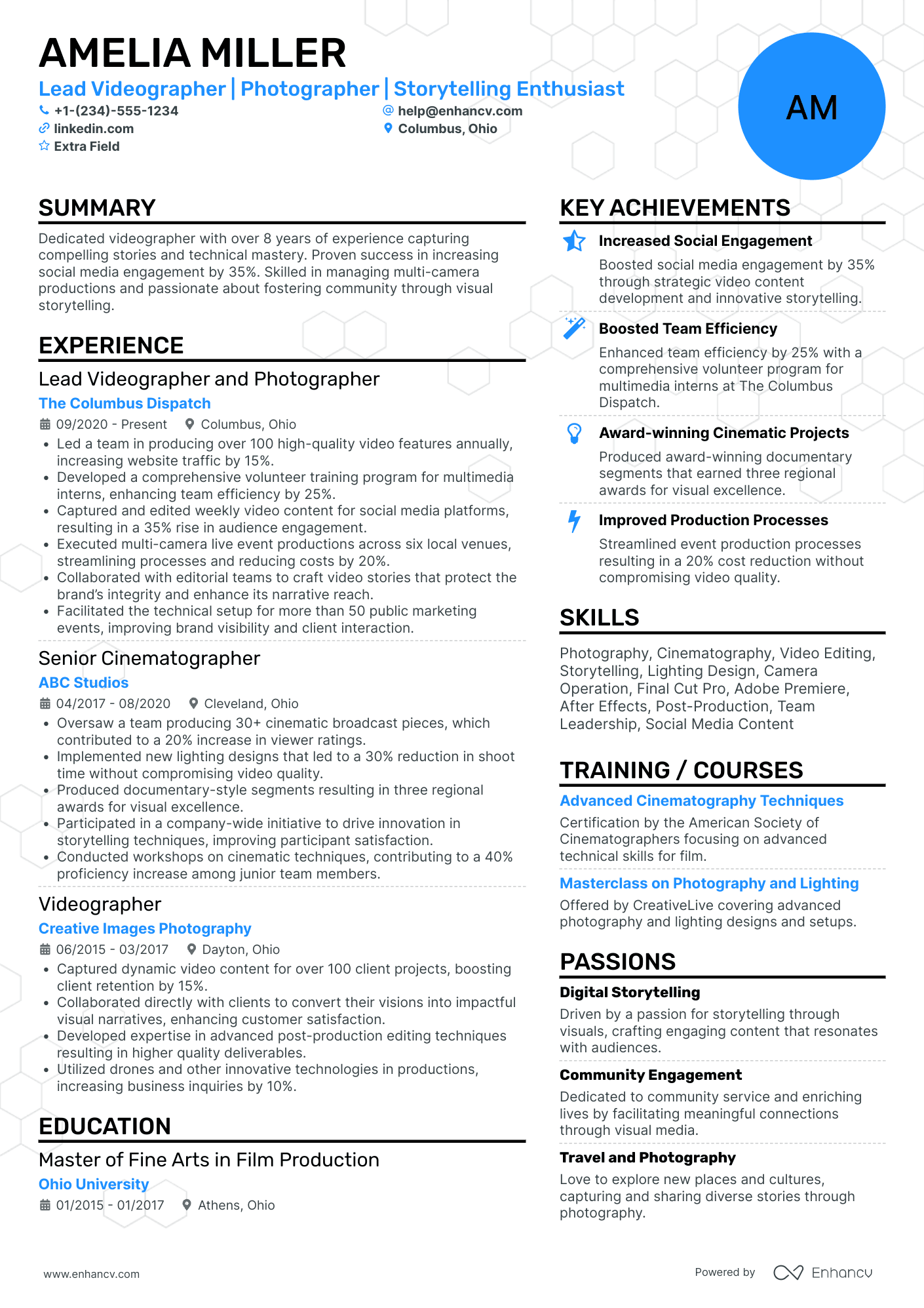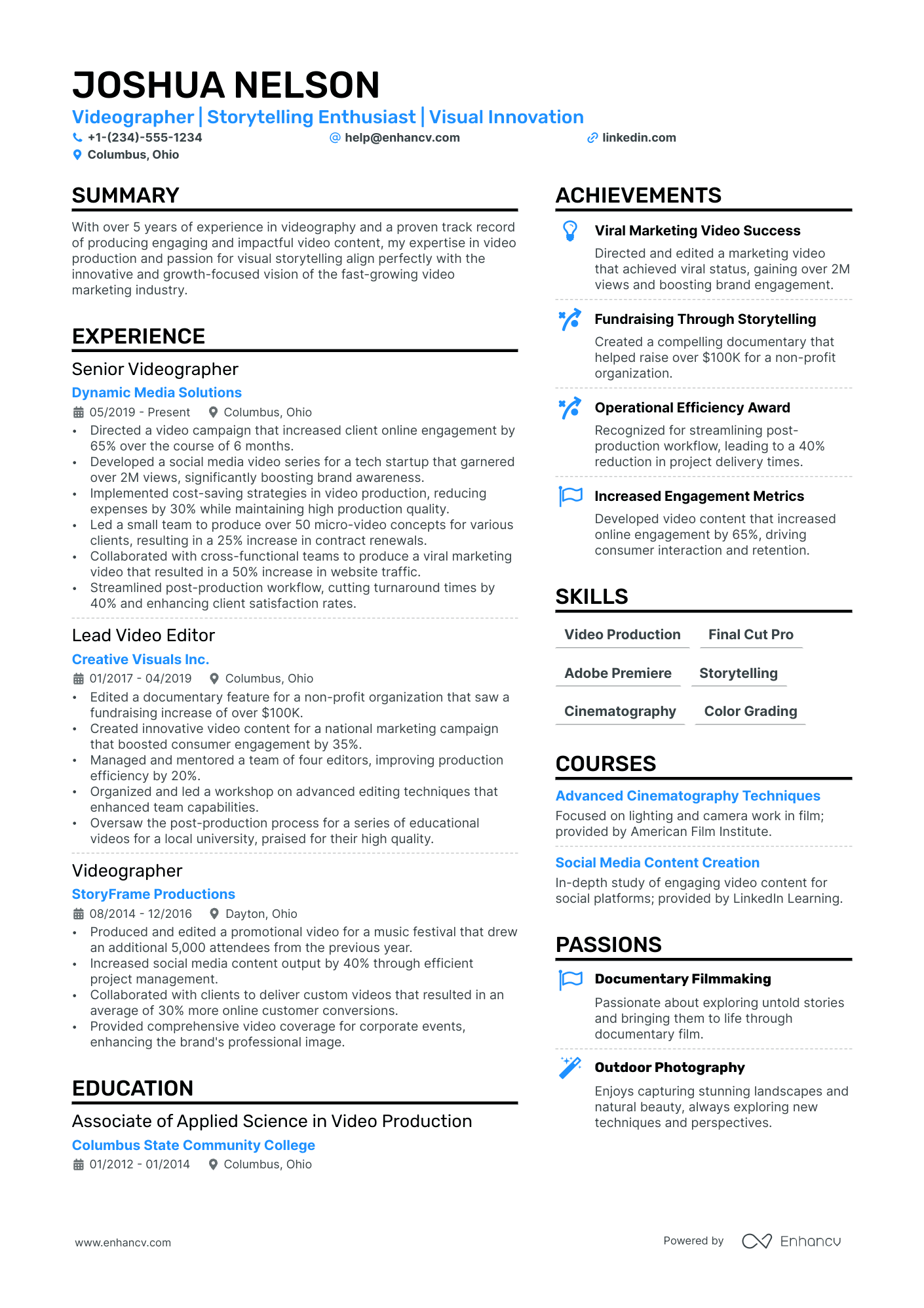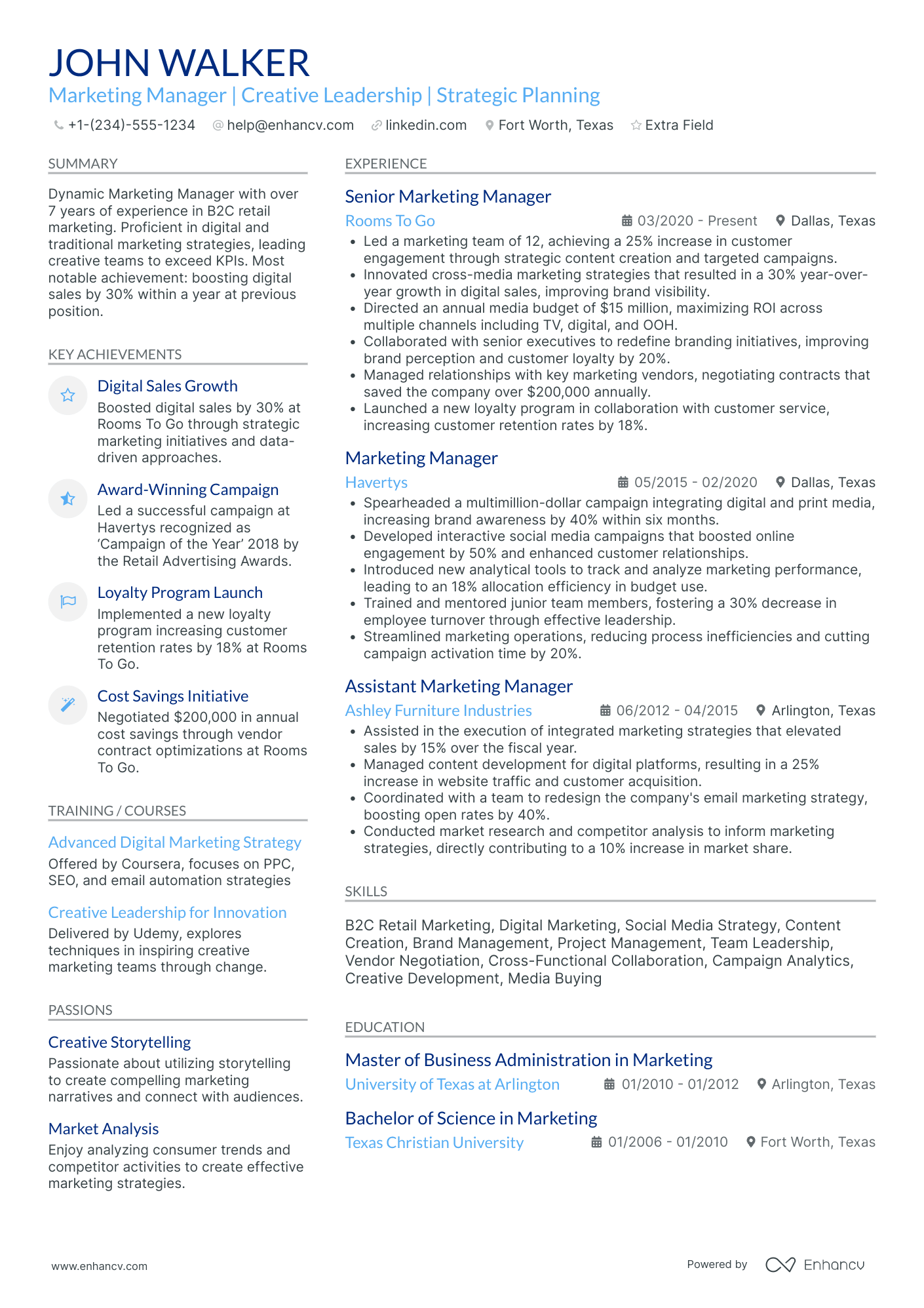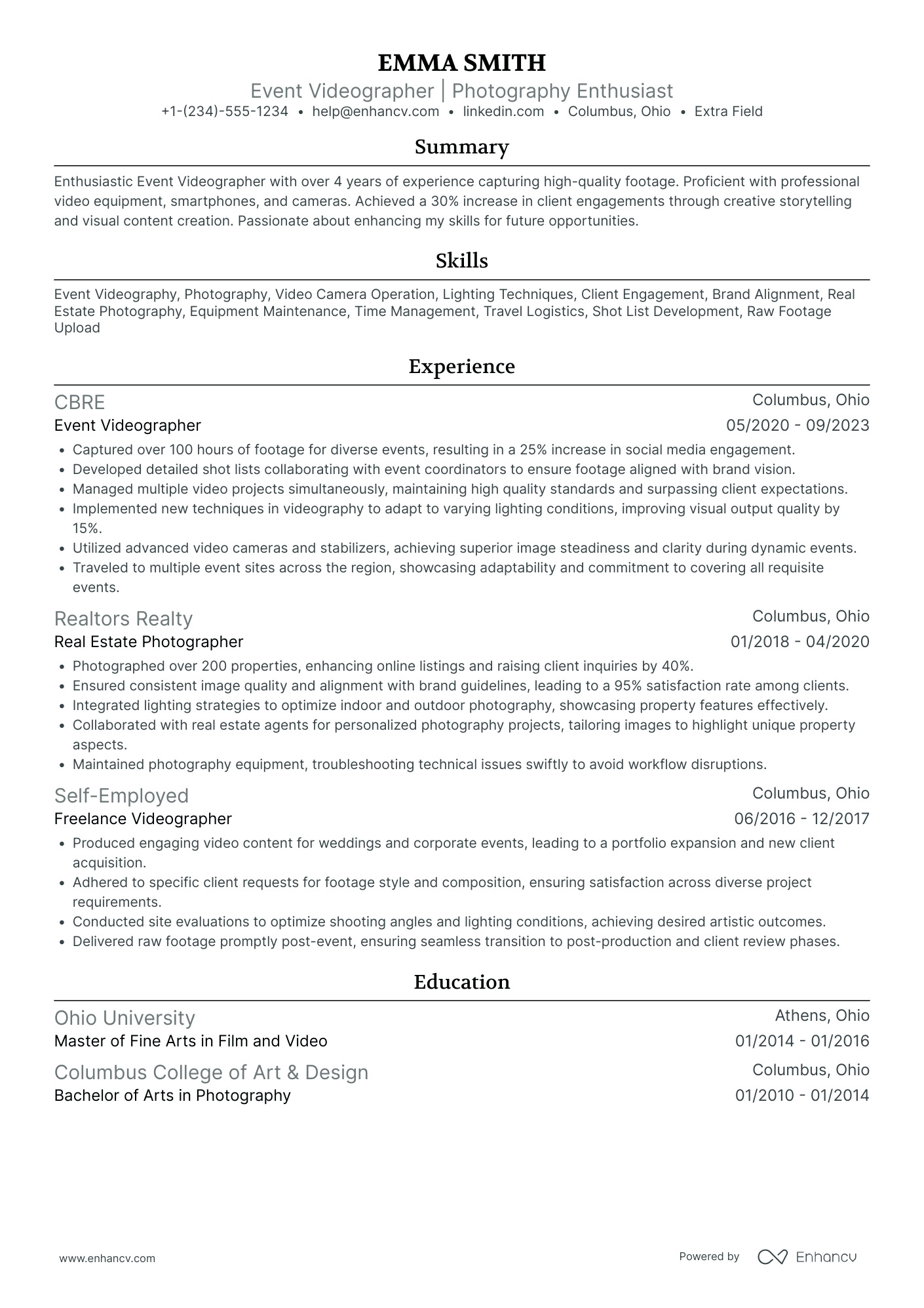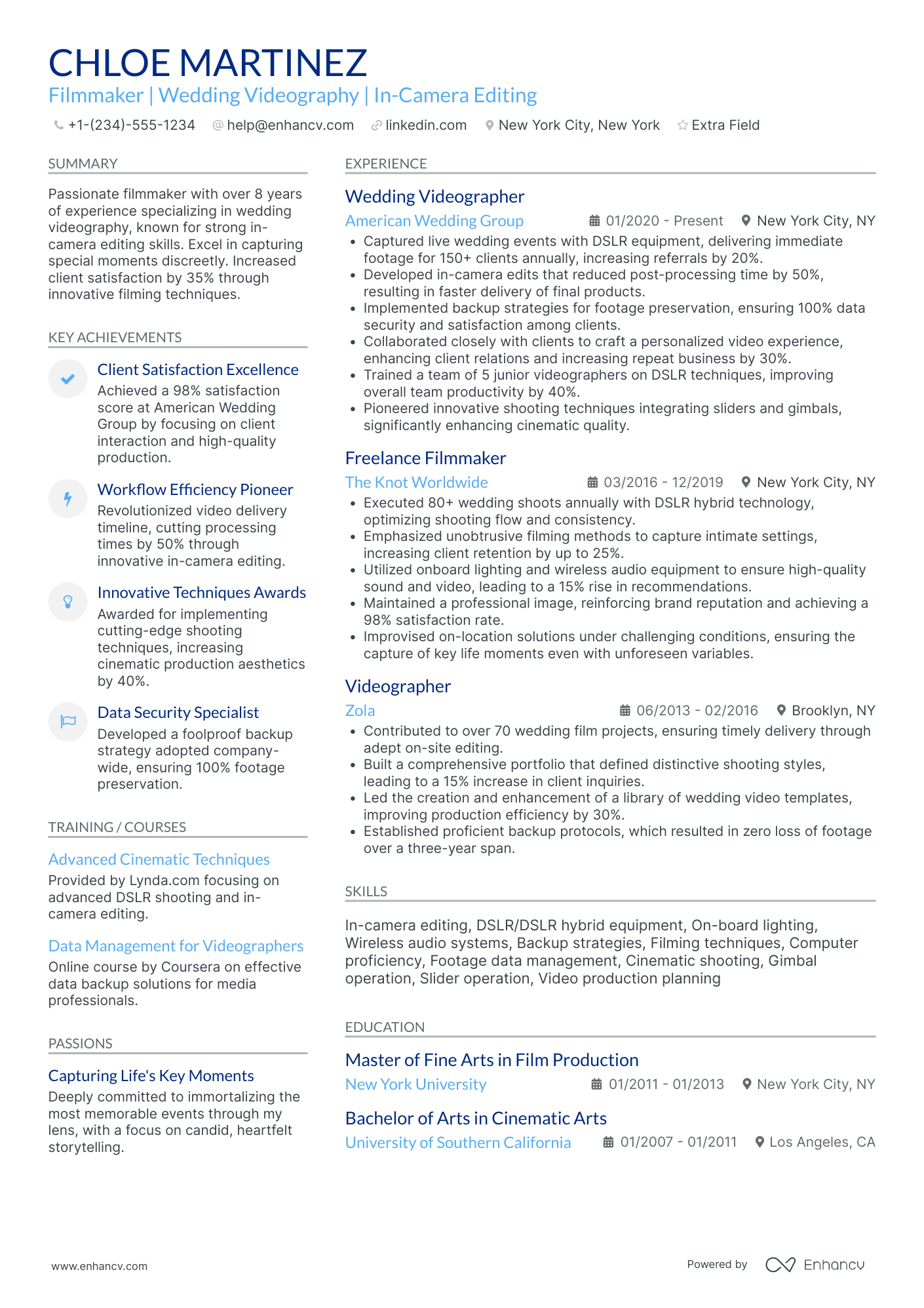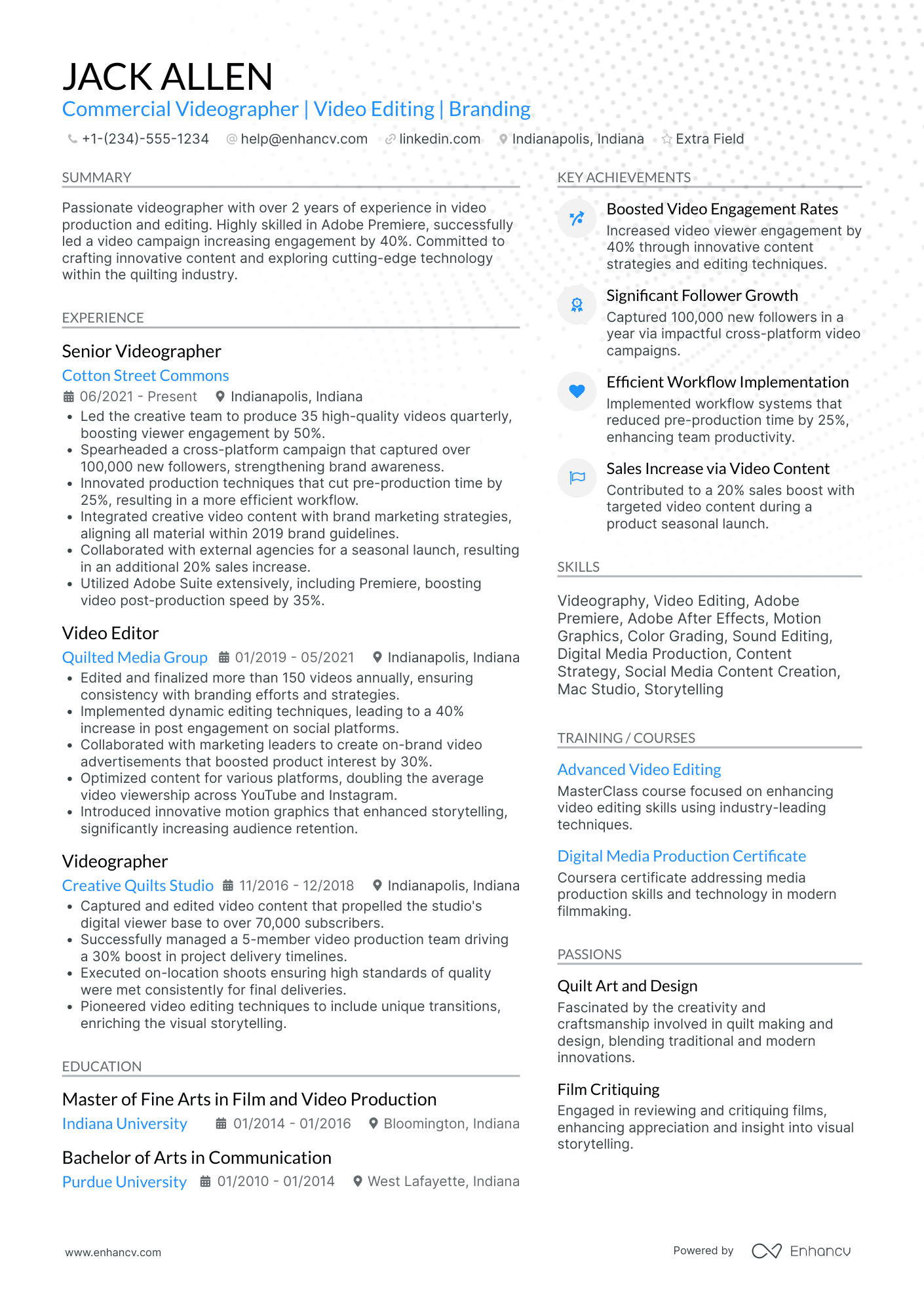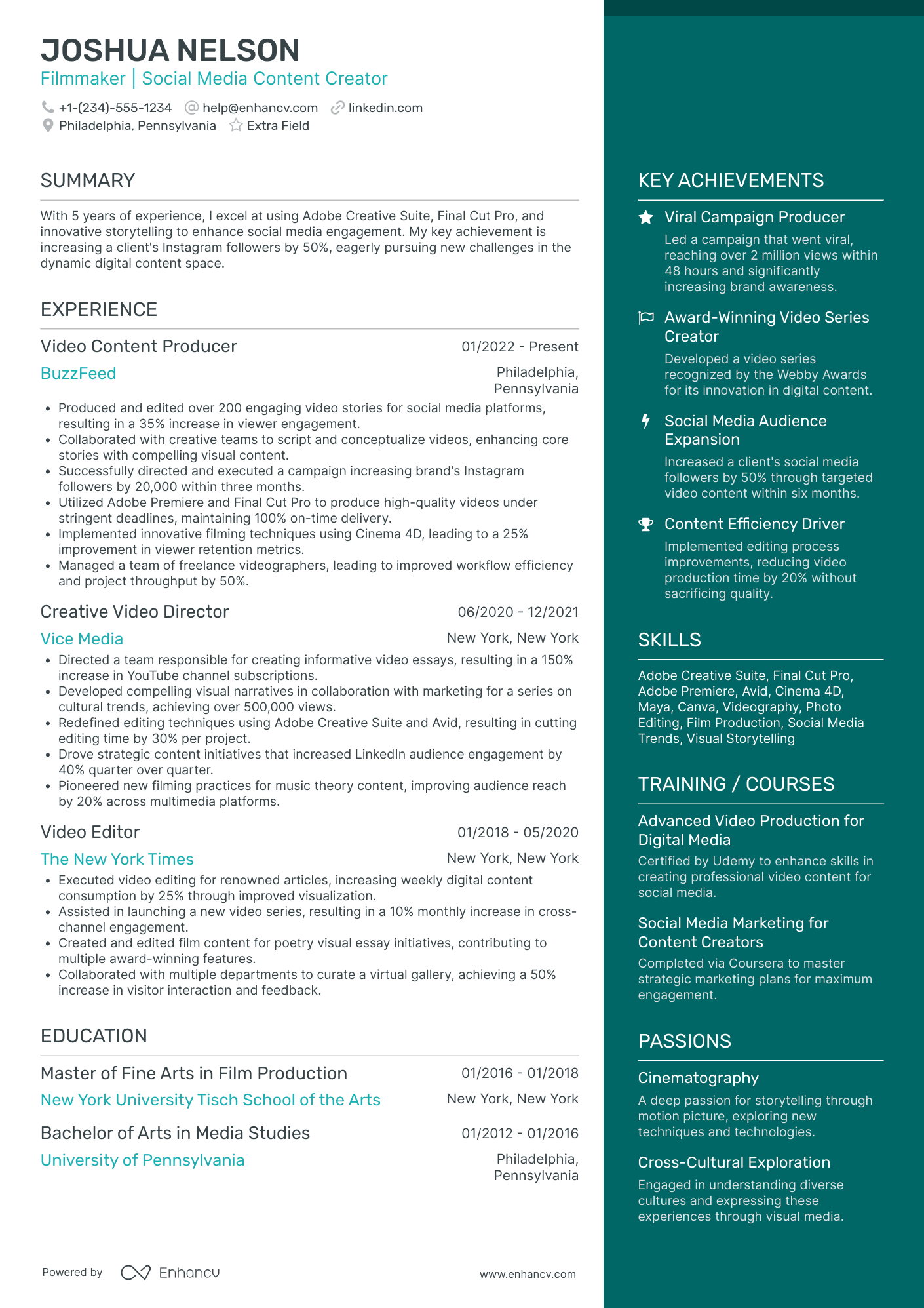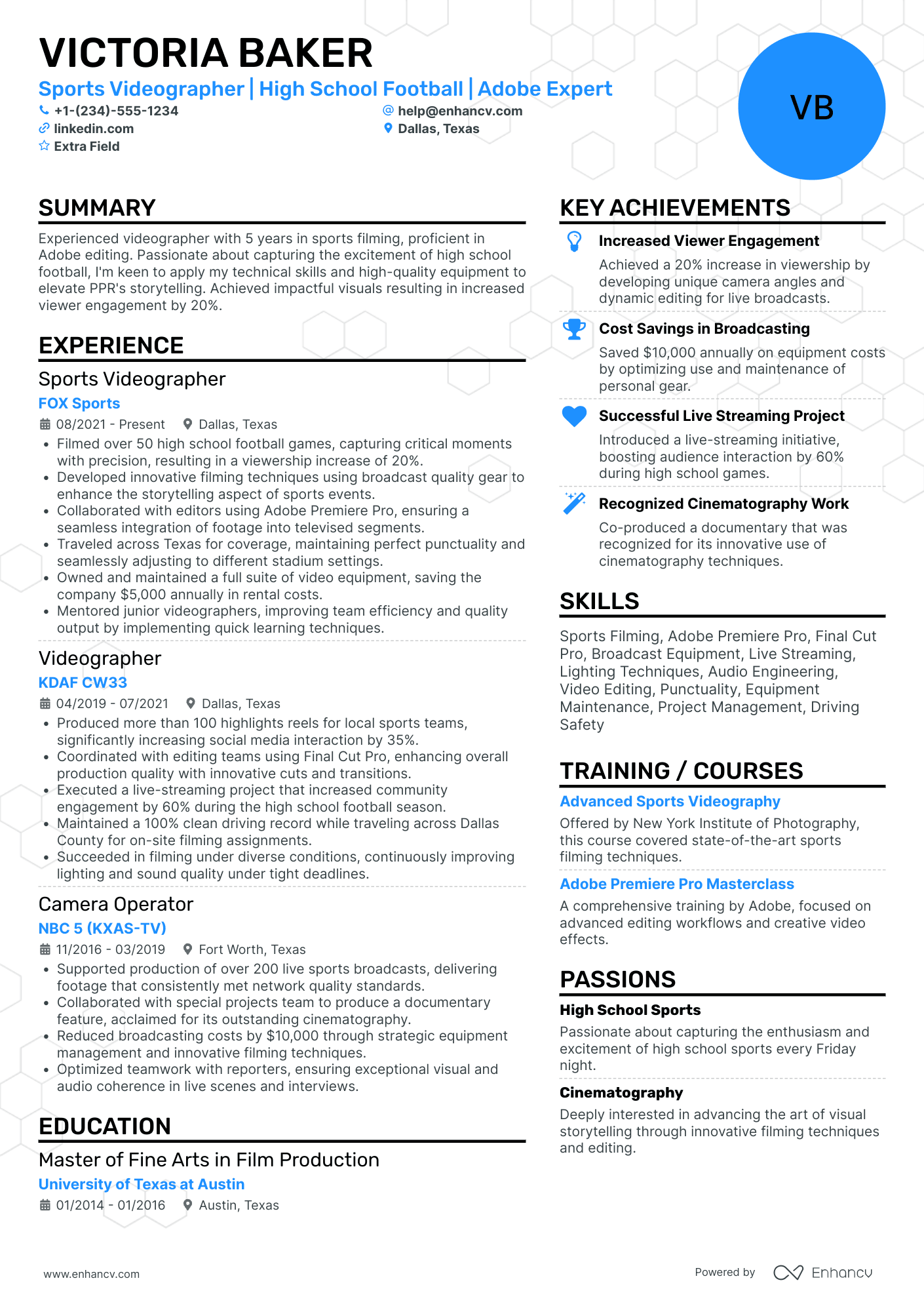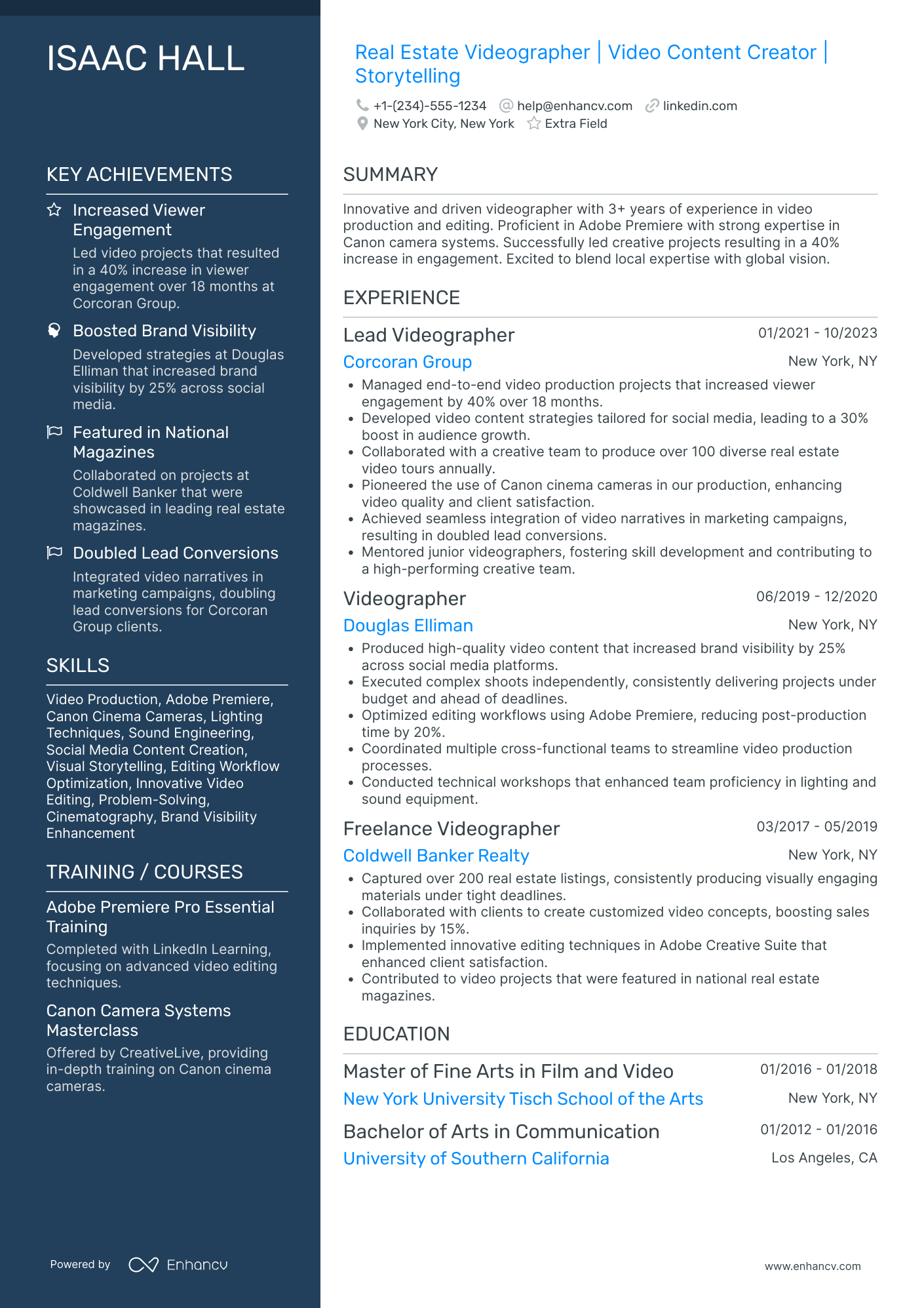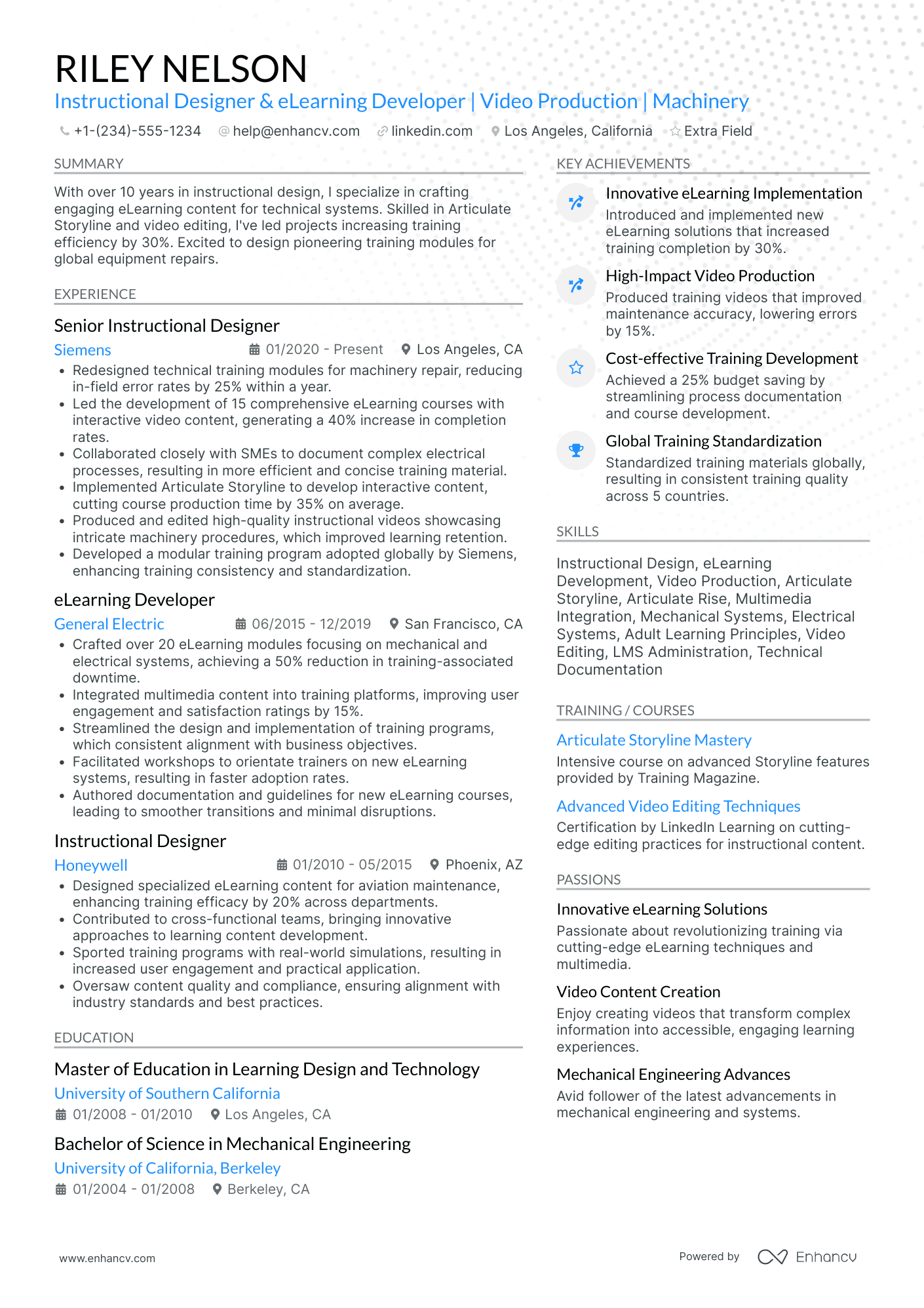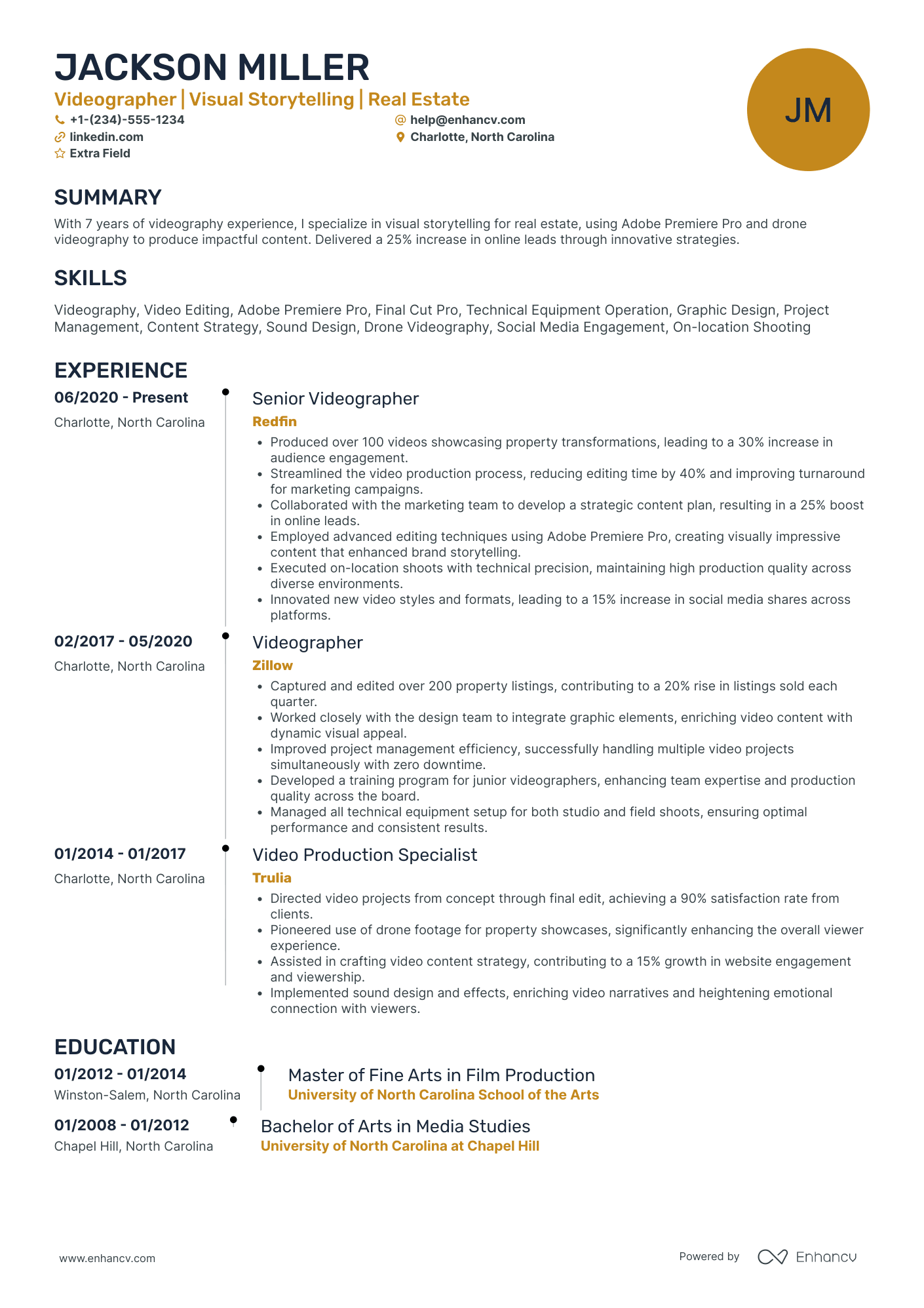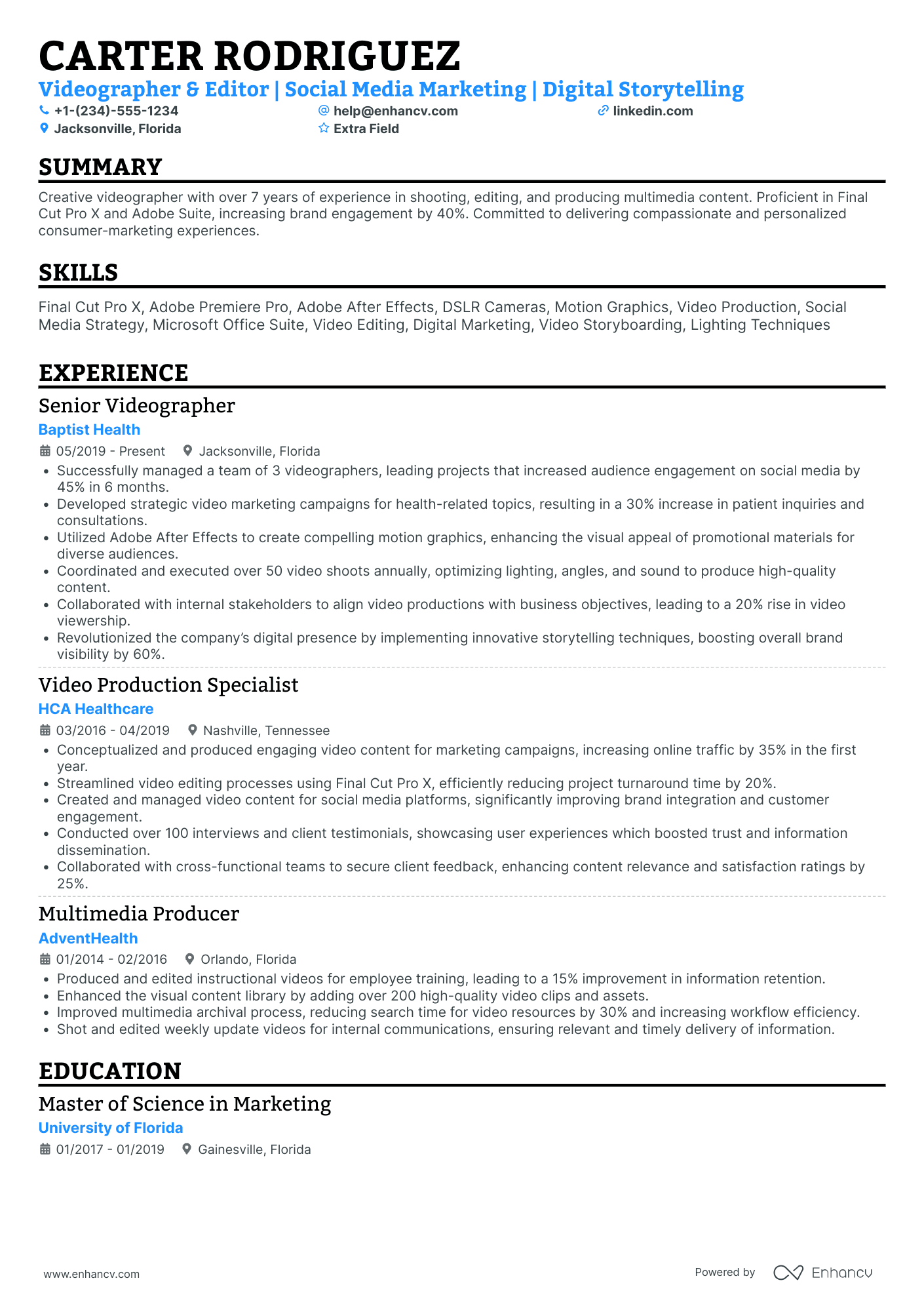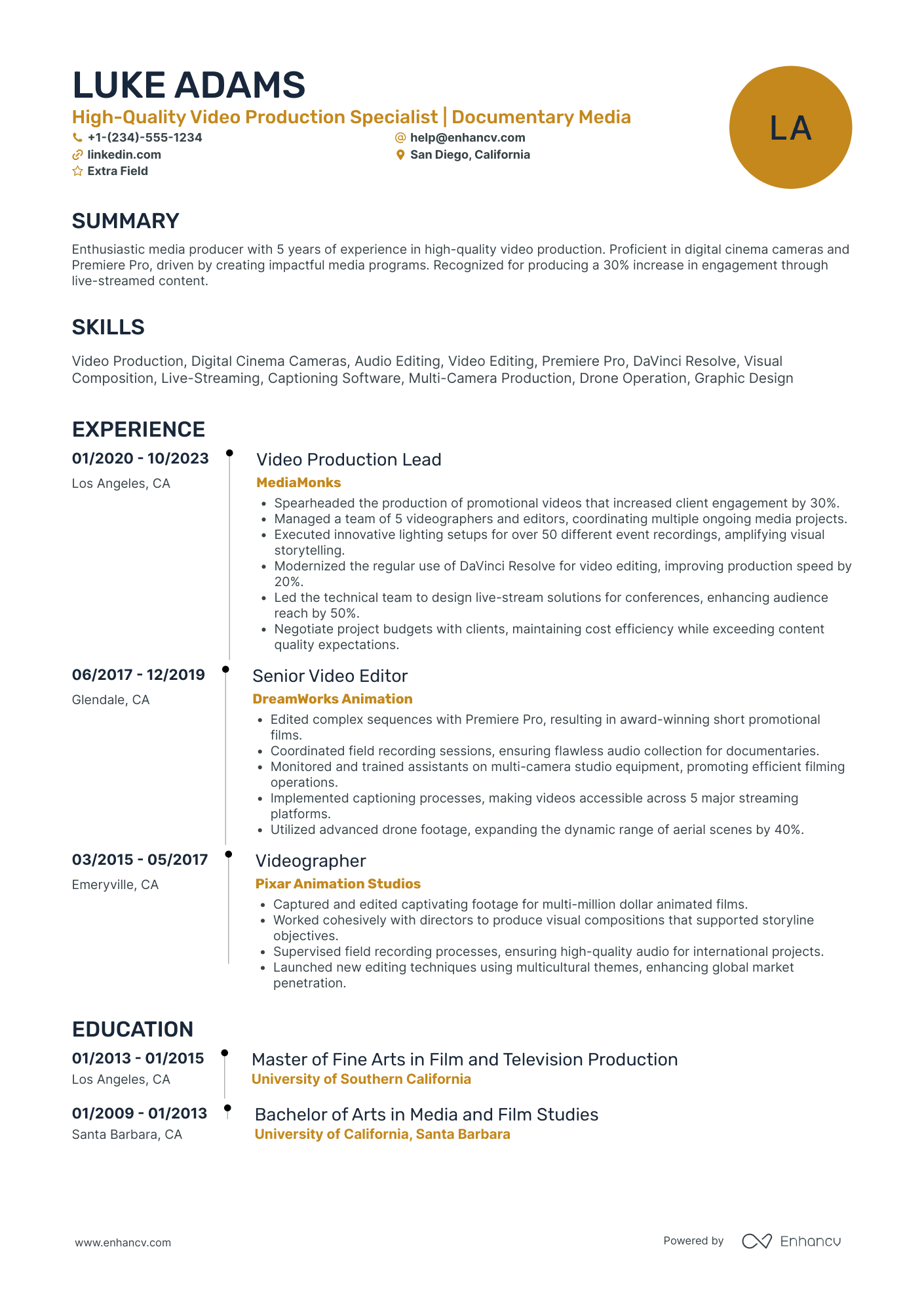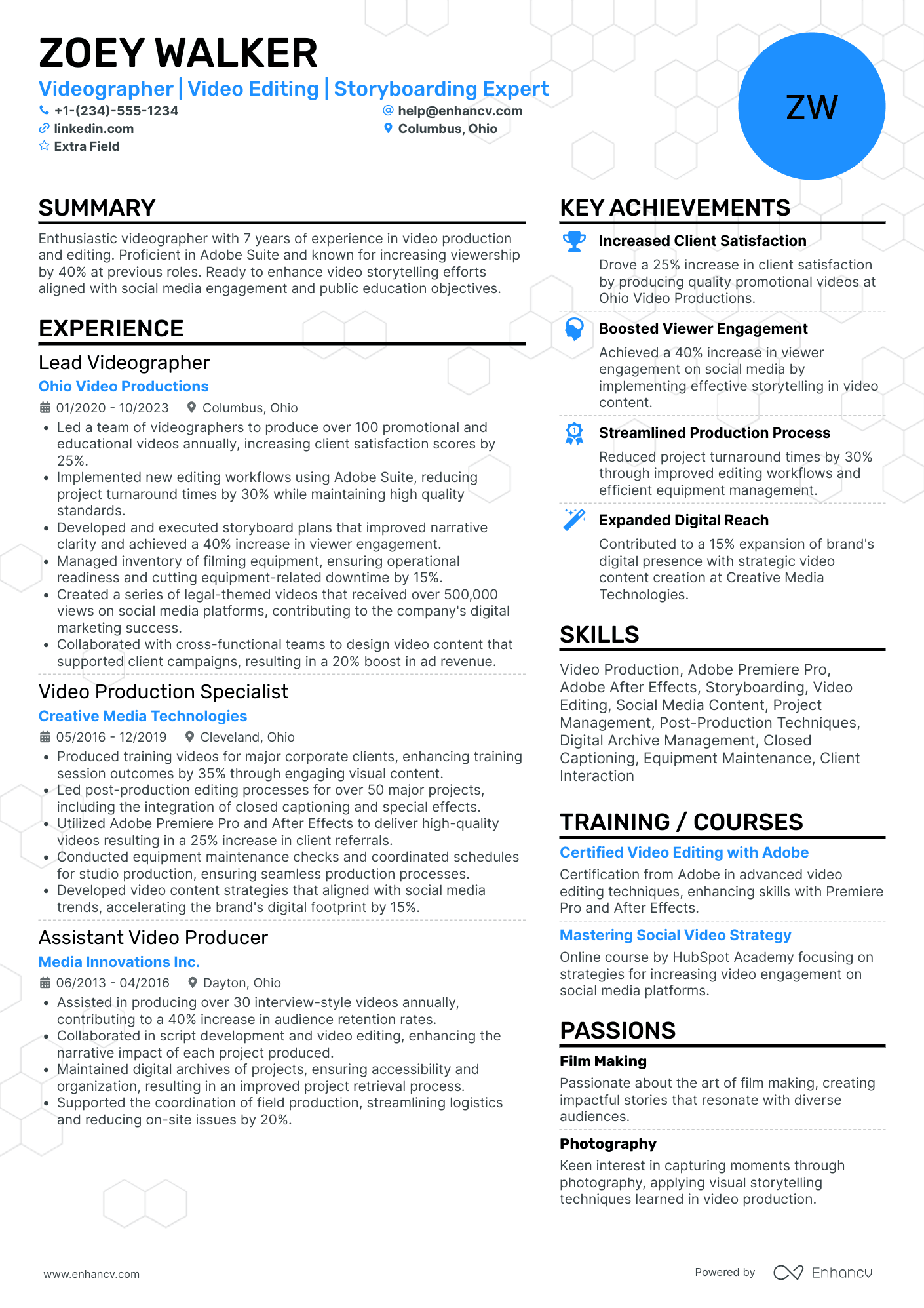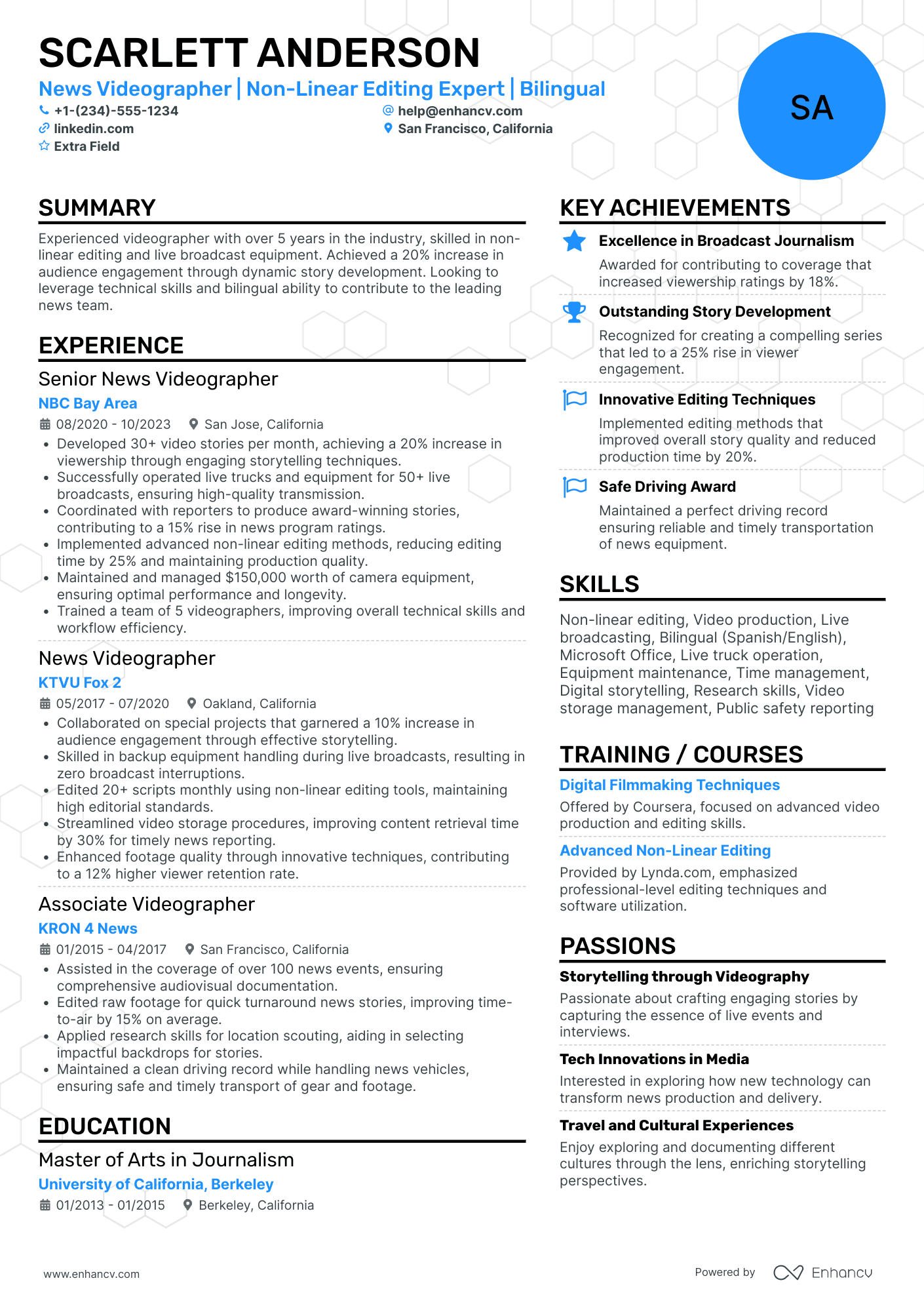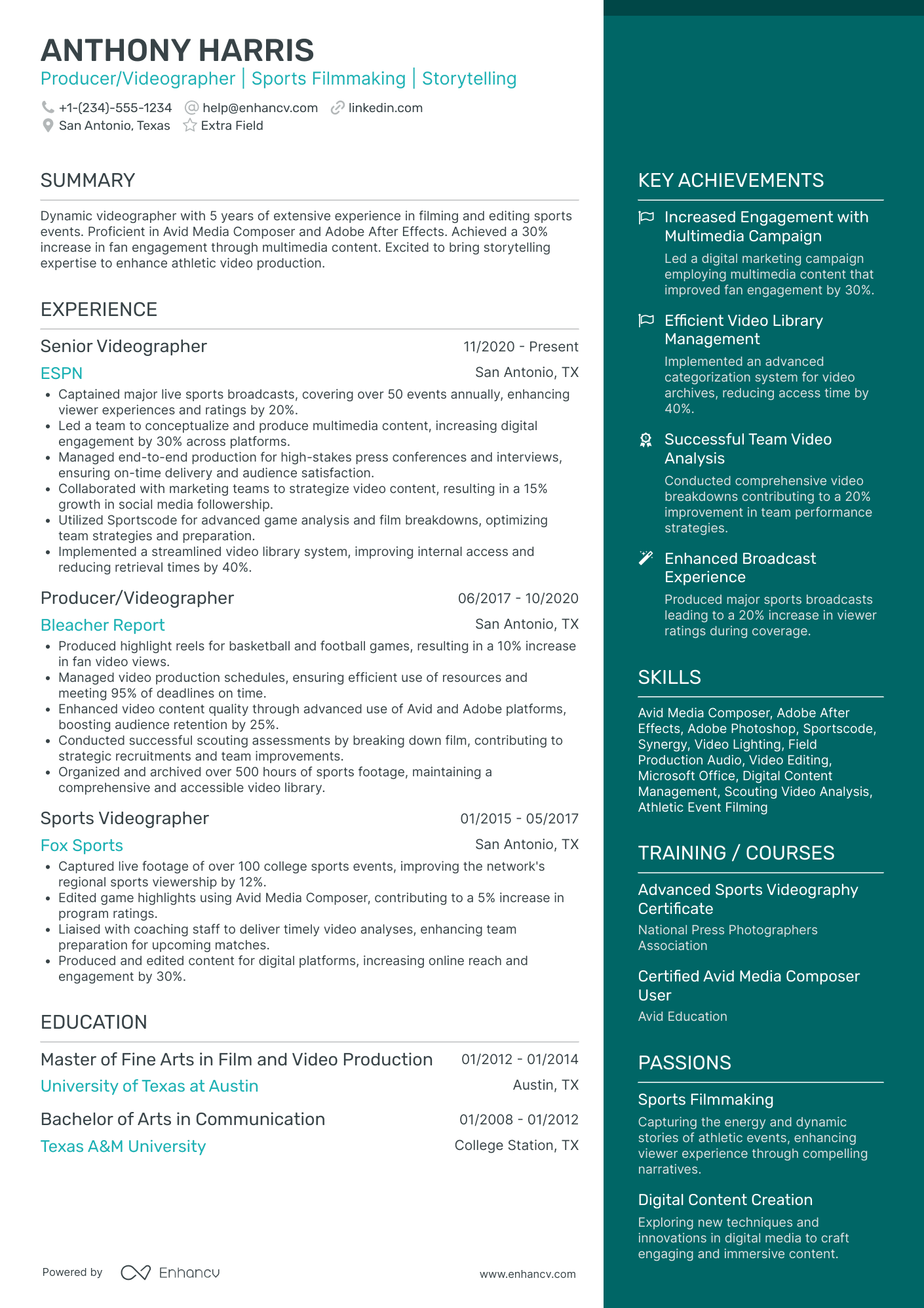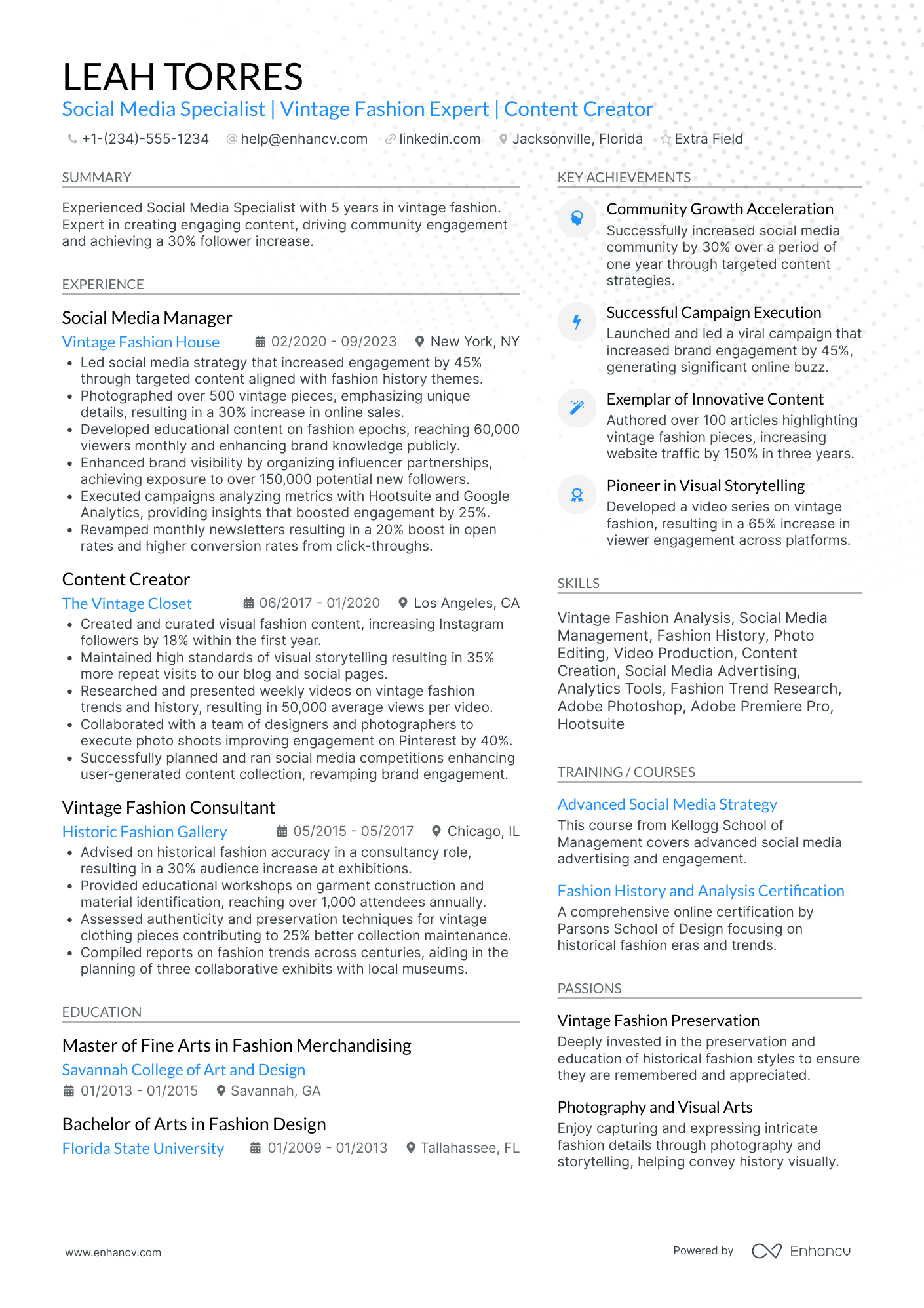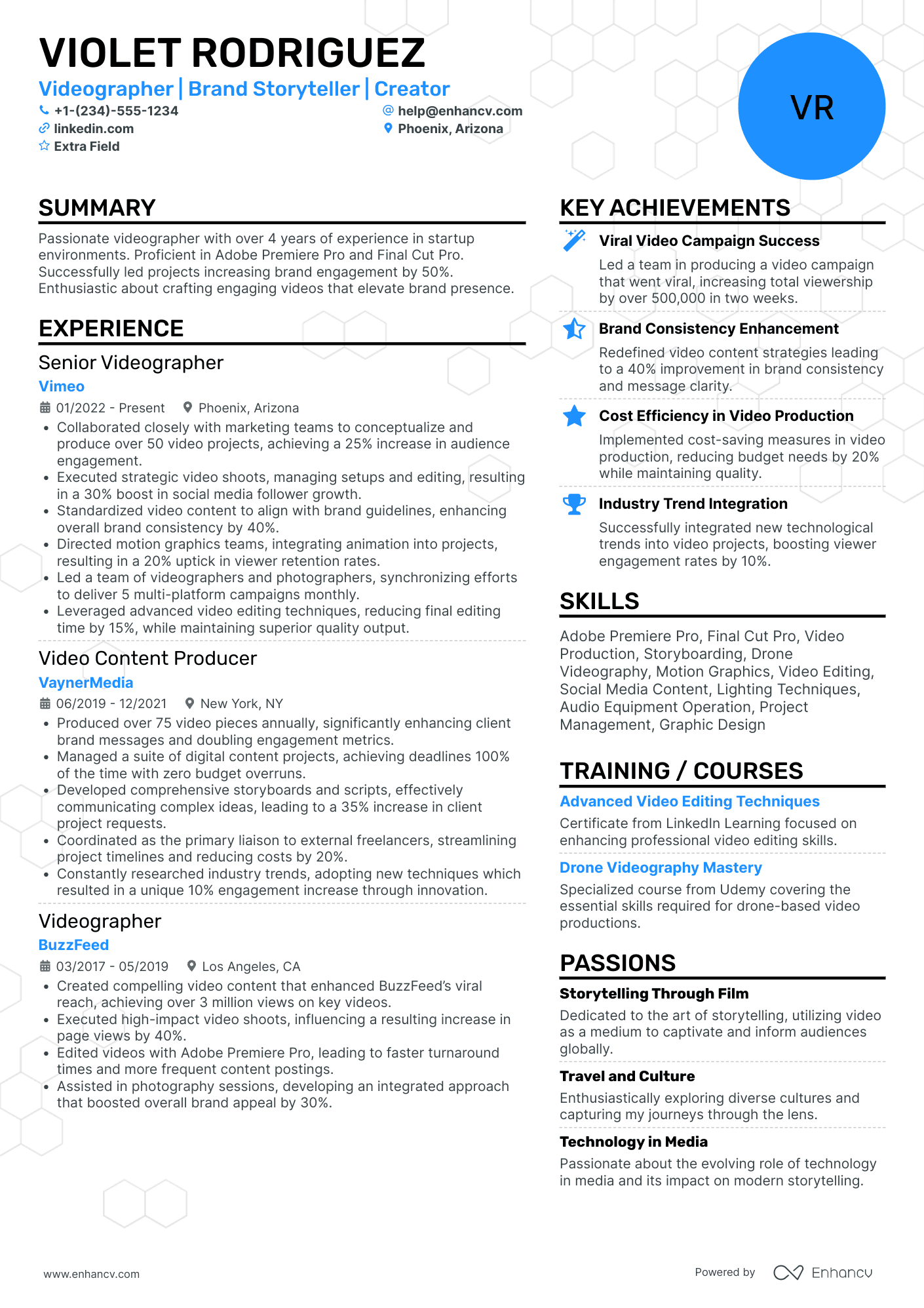As a videographer, one specific resume challenge you might face is effectively showcasing your technical skills and creative projects to stand out in a competitive industry. Our guide will provide you with strategies for highlighting your visual storytelling abilities and tailoring your resume to accentuate your most impressive work, ensuring you grab the attention of potential employers.
- Defining the highlights of your videographer career through your resume summary, objective, and experience.
- Real-world videographer resume samples with best practices on how to stand out amongst the endless pile of candidate resumes.
- Most in-demand videographer resume skills and certifications across the industry.
- Standardizing your resume layout, while maintaining your creativity and individuality.
If the videographer resume isn't the right one for you, take a look at other related guides we have:
Don't stress out over your videographer resume format
Remember, the elaborate design of your videographer resume isn't what impresses recruiters most. They are primarily searching for candidates who meet the job requirements. The main aim of your resume should be to clearly and concisely explain why employers should hire you.
Here are four straightforward steps to consider in your videographer resume design:
- Organize your resume based on experience: Start with your most recent roles. Besides using reverse chronological order, choose jobs relevant to the position you're applying for.
- Include your contact details (and portfolio or LinkedIn link) in your resume's header to ensure recruiters can easily reach you. If considering adding a professional photo, check acceptable practices in different countries first.
- Don't omit essential videographer resume sections such as the summary or objective, experience, and education. These sections should reflect your career progression and align with job requirements.
- Maintain conciseness in your resume. For those with less than ten years of experience, a one-page format is advisable.
Regarding the format to submit your videographer resume, PDF is preferable. PDFs are more likely to maintain their formatting when processed through recruitment software or ATS, saving you time in the application process.
When selecting a font for your videographer resume, consider the following:
- Choose ATS-friendly fonts such as Exo 2, Volkhov, Lato, etc., to keep your resume's content legible;
- All serif and sans-serif fonts are easily readable by ATS;
- While Arial and Times New Roman are common choices, opting for unique typography can help your resume stand out.
Concerned about ATS compatibility with charts and infographics? Our recent study has debunked this and other myths.
Be aware of location-based layout differences – Canadian resumes, for instance, might differ in format.
Upload & Check Your Resume
Drop your resume here or choose a file. PDF & DOCX only. Max 2MB file size.
PRO TIP
If the certificate you've obtained is especially vital for the industry or company, include it as part of your name within the resume headline.
Fundamental sections for your videographer resume:
- The header with your name (if your degree or certification is impressive, you can add the title as a follow up to your name), contact details, portfolio link, and headline
- The summary or objective aligning your career and resume achievements with the role
- The experience section to curate neatly organized bullets with your tangible at-work-success
- Skills listed through various sections of your resume and within an exclusive sidebar
- The education and certifications for more credibility and industry-wide expertise
What recruiters want to see on your resume:
- Proficiency in video editing software (e.g., Adobe Premiere Pro, Final Cut Pro).
- Demonstrable experience with creating compelling and engaging video content.
- Understanding of the principles of cinematography, including lighting, shot composition, and camera operation.
- Experience with different types of video projects (e.g., commercials, documentaries, corporate videos).
- Technical skills with video equipment, such as DSLRs, camcorders, lighting gear, and audio recording devices.
Quick guide to your videographer resume experience section
After deciding on the format of your resume, it's time to organize your experience within the dedicated section.
It's common for videographer professionals to be confused in this part of the process, as they may have too much or little expertise.
Follow the general rules of thumb to be successful when writing this part of your resume:
- The perfect number of bullets you should have under each experience item is no more than six;
- Select not merely your responsibilities, but the most noteworthy achievements for each role that match the job requirements;
- List any certificates or technical expertise you've gained on the job and how they've helped you progress as a professional;
- Carefully select the power verbs to go along with each bullet to avoid generic ones like "managed" and instead substitute those with the actuality of your particular responsibility;
- Integrate valuable keywords from the job advert in the form of achievements under each role you list.
If you're on the search for further advice on how to write your videographer experience section, get some ideas from real-world professional resumes:
- Led a team of 4, developing 150+ corporate videos that increased client company's brand engagement by 35% through social media channels.
- Implemented advanced color-grading techniques that improved the visual aesthetics of client deliverables and increased customer satisfaction ratings by 40%.
- Streamlined post-production workflow by integrating new editing software, reducing project turnaround time by 25%.
- Supervised cinematography for a featured documentary that received the Audience Choice Award at Sundance Film Festival.
- Managed all technical aspects of video recording and editing, resulting in a 20% increase in production efficiency.
- Coordinated with the creative team to ensure all video content aligned with the narrative needs and company standards.
- Produced and edited 200+ event videos for clients, including weddings and corporate gatherings, boasting a 100% client satisfaction rate.
- Increased freelance business revenue by 50% through referrals from satisfied customers and repeated business.
- Expanded service offerings by adopting aerial videography, adding a unique selling proposition to my freelance business.
- Curated multimedia content for web distribution which raised online conversions by 30% over two years.
- Collaborated with marketing team to create promotional videos, driving a 15% increase in campaign ROI.
- Enhanced the live streaming setup, allowing for a 20% upsurge in viewer engagement during events.
- Orchestrated the production of a viral marketing campaign video series which amassed over 5M views across platforms.
- Boosted team productivity by 30% by implementing agile methodologies in the video production process.
- Negotiated contracts with vendors leading to a decrease in production costs by 20%, without compromising quality.
- Conceptualized and executed video content that contributed to a 45% increase in viewer retention rates for a popular YouTube channel.
- Trained a creative team of 5 in cutting-edge videography techniques to ensure consistent quality across all productions.
- Established a digital asset management system, significantly elevating the efficiency of accessing and retrieving project files for the team.
- Developed and produced an award-winning short film that screened at multiple international film festivals.
- Crafted compelling video narratives that contributed to a 25% year-over-year growth in the non-profit's donor base.
- Optimized on-set workflows, allowing our production team to complete projects an average of 2 days ahead of schedule.
- Created engaging e-learning video content, which helped increase the course completion rate by 30% for an education platform.
- Pioneered the implementation of 360-degree virtual reality videos, creating immersive experiences for training modules.
- Managed video production budgets effectively, ensuring all projects were delivered under budget by at least 15%.
The following content includes information from "O*NET OnLine" by the U.S. Department of Labor, Employment and Training Administration (USDOL/ETA). Used under the CC BY 4.0 license. The data represents the top responsibilities present on the task lists for videographer professionals.
Top Responsibilities for Videographer:
- Compose and frame each shot, applying the technical aspects of light, lenses, film, filters, and camera settings to achieve the effects sought by directors.
- Operate television or motion picture cameras to record scenes for television broadcasts, advertising, or motion pictures.
- Adjust positions and controls of cameras, printers, and related equipment to change focus, exposure, and lighting.
- Confer with directors, sound and lighting technicians, electricians, and other crew members to discuss assignments and determine filming sequences, desired effects, camera movements, and lighting requirements.
- Operate zoom lenses, changing images according to specifications and rehearsal instructions.
- Observe sets or locations for potential problems and to determine filming and lighting requirements.
- Set up and perform live shots for broadcast.
- Use cameras in any of several different camera mounts, such as stationary, track-mounted, or crane-mounted.
- Test, clean, maintain, and repair broadcast equipment, including testing microphones, to ensure proper working condition.
- Edit video for broadcast productions, including non-linear editing.
Quantifying impact on your resume
- Include the total number of video projects completed to showcase experience and productivity.
- List the average percentage of client satisfaction based on feedback to highlight client-centric results.
- Specify the gross revenue generated from videos created for marketing campaigns to demonstrate financial impact.
- Document the percentage of projects delivered by the deadline to prove time management skills.
- State the number of views or shares for the most successful video content to show reach and engagement.
- Report the average reduction in project turnaround time after process improvements to illustrate efficiency gains.
- Quantify the size of teams managed or collaborated with on projects to reveal leadership and teamwork capabilities.
- Mention the percentage increase in social media followers or subscribers due to video content to show audience growth.
Action verbs for your videographer resume
Making the most of your little to none professional experience
If you're hesitant to apply for your dream job due to limited professional experience, remember that recruiters also value the unique contributions you can offer.
Next time you doubt applying, consider this step-by-step approach for your resume's experience section:
- Rather than the standard reverse chronological order, opt for a functional-based format. This shifts the focus from your work history to your achievements and strengths;
- Include relevant internships, volunteer work, or other non-standard experiences in your videographer resume's experience section;
- Utilize your education, qualifications, and certifications to bridge gaps in your videographer resume experience;
- Emphasize your interpersonal skills and transferable skills from various industries. Often, recruiters seek a personality match, giving you an advantage over other candidates.
Recommended reads:
PRO TIP
Mention specific courses or projects that are pertinent to the job you're applying for.
Popular videographer hard skills and soft skills for your resume
Apart from assessing your professional expertise, recruiters are on the lookout for whether your skills align with the job.
Your profile would thus be assessed in regard to your:
- Hard or technical skills - your ability to perform on the job using particular technologies or software
- Soft skills - how you adapt, communicate, and thrive in different environments.
Both types of skills - hard and soft skills - are important for your resume, so make sure to create a dedicated skills section that:
- Lists up to five or six skills that align with the job advert.
- Integrates vital keywords for the industry, but also reflects on your personal strengths.
- Builds up further your skills with an achievements section within which you explain what you've achieved thanks to using the particular skill.
- Aims to always quantify in some way how you've used the skill, as it's not enough to just list it.
What are the most sought out hard and soft skills for videographer roles?
Check out the industry's top choices with our two dedicated lists below:
Top skills for your videographer resume:
Adobe Premiere Pro
Final Cut Pro
DaVinci Resolve
Canon DSLR Cameras
Sony Mirrorless Cameras
Lighting Techniques
Audio Recording Equipment
Post-Production Editing
Video Compression Techniques
Drone Operation
Creativity
Attention to Detail
Time Management
Communication
Problem-Solving
Collaboration
Adaptability
Critical Thinking
Storytelling
Project Management
Next, you will find information on the top technologies for videographer professonals from "O*NET OnLine" by the U.S. Department of Labor, Employment and Training Administration (USDOL/ETA). Used under the CC BY 4.0 license.
Top technologies for Videographer’s resume:
- Adobe After Effects
- YouTube
- Adobe Creative Cloud software
- Adobe Illustrator
- Litchi
- Pix4D Pix4Dcapture
PRO TIP
Bold the names of educational institutions and certifying bodies for emphasis.
How to include your education and certifications on your resume
We're taking you back to your college days with this part of our guide, but including your relevant higher education is quite important for your resume.
Your degree shows recruiters your dedication to the industry, your recent and relevant know-how, and some form of experience in the field.
Your videographer resume education should:
- Include your applicable degrees, college (-s) you've graduated from, as well as start and end dates of your higher education;
- Skip your high school diploma. If you still haven't graduated with your degree, list that your higher education isongoing;
- Feature any postgraduate diplomas in your resume header or summary - this is the perfect space to spotlight your relevant MBA degree;
- Showcase any relevant coursework, if you happen to have less professional experience and think this would support your case in being the best candidate for the role.
As far as your job-specific certificates are concerned - choose up to several of the most recent ones that match the job profile, and include them in a dedicated section.
We've saved you some time by selecting the most prominent industry certificates below.
The top 5 certifications for your videographer resume:
- Certified Professional videographer (CPV) - Professional Photographers of America (PPA)
- Adobe Certified Expert (ACE) - Adobe
- Final Cut Pro X (FCP X) Certification - Apple
- Blackmagic Design Certified Trainer (BMCT) - Blackmagic Design
- Avid Certified Professional (ACP) - Avid Technology
The content below includes information from "O*NET OnLine" by the U.S. Department of Labor, Employment and Training Administration (USDOL/ETA). Used under the CC BY 4.0 license. The data represents the top associations for videographer professionals.
Top US associations for a Videographer professional
- American Guild of Court Videographers
- Association for Uncrewed Vehicle Systems International
- Drone Safety Team
- International Alliance of Theatrical Stage Employees, Moving Picture Technicians, Artists and Allied Crafts
- International Brotherhood of Electrical Workers
PRO TIP
List your educational qualifications and certifications in reverse chronological order.
Recommended reads:
The ideal videographer candidate resume summary or objective
You may have heard that your resume top one-third plays an important part in your application.
It basically needs to show strong alignment with the job advert, your unique skill set, and your expertise.
Both the resume summary and resume objective could be used to ensure you've shown why you're the best candidate for the role.
Use the:
- Resume objective to pinpoint your current successes, that are applicable to the field, and your vision for your career. Remember to state how you see yourself growing within this new career opportunity.
- Resume summary as an instrument to pinpoint what is most applicable and noteworthy form your professional profile. Keep your summary to be no more than five sentences long.
At the end of the day, the resume summary or objective is your golden opportunity to shine a light on your personality as a professional and the unique value of what it's like to work with you.
Get inspired with these videographer resume examples:
Resume summaries for a videographer job
- Seasoned videographer with over 8 years of experience capturing compelling stories through the lens for major news outlets. Renowned for advanced skills in DSLR cinematography and Adobe Creative Suite editing, having won the prestigious National Visual Storytelling Award in 2021.
- Adept at creative visual storytelling, with a rich 6-year background in corporate videography, I bring a portfolio that highlights multinational campaigns, mastery in drone operation, and proficiency in Final Cut Pro. Pivotal in expanding a boutique studio's reach by 150% through targeted video marketing.
- Former journalist eager to leverage a decade of experience in crafting engaging narratives into the art of videography. Profoundly skilled in research and fact-checking, I am excited to apply a journalistic eye to producing impactful visual content with advanced videography training.
- Web developer transitioning to a videography career, bringing a unique perspective with 5 years of experience in visual design and coding. Passionate about combining technical proficiency with storytelling and recently having completed a comprehensive course in video production and cinematography.
- Energetic visionary eager to embark on a career in videography, with a fresh diploma from New York Film Academy. My objective is to create memorable visual experiences, utilizing my foundational knowledge in lighting, composition, and post-production, inspired by the evocative power of cinematic storytelling.
- Recent graduate with a Bachelor’s in Film Studies, aiming to apply theoretical knowledge into practical expertise as a videographer. Determined to harness my passion for film and multimedia production to craft engaging content that resonates with audiences and aligns with creative visions.
Optimize your resume summary and objective for ATS
Drop your resume here or choose a file.
PDF & DOCX only. Max 2MB file size.
Average salary info by state in the US for videographer professionals
Local salary info for Videographer.” Source: My Next Move, National Center for O*NET Development. Accessed 10/15/2024
| State | Average Salary (in USD) |
|---|---|
| US National Average | $61,800 |
| California (CA) | $67,950 |
| Texas (TX) | $62,700 |
| Florida (FL) | $50,600 |
| New York (NY) | $93,880 |
| Pennsylvania (PA) | $49,350 |
| Illinois (IL) | $38,170 |
| Ohio (OH) | $48,840 |
| Georgia (GA) | $59,140 |
| North Carolina (NC) | $62,420 |
| Michigan (MI) | $51,450 |
Beyond your videographer resume basics - extra sections
Ensure your videographer resume stands out from the crowd by spicing it up with a couple of supplementary sections that showcase your:
- Prizes - as a special nod to what matters most in the field;
- Projects - ones that would really further support your application;
- Hobbies - include only if you think they'd further your chances at landing the role with personality
- Community impact - to hint at the causes you care about.
Key takeaways
At the end of our guide, we'd like to remind you to:
- Invest in a simple, modern resume design that is ATS friendly and keeps your experience organized and legible;
- Avoid just listing your responsibilities in your experience section, but rather focus on quantifiable achievements;
- Always select resume sections that are relevant to the role and can answer job requirements. Sometimes your volunteering experience could bring more value than irrelevant work experience;
- Balance your technical background with your personality traits across various sections of your resume to hint at how much time employers would have to invest in training you and if your profile would be a good cultural fit to the organization;
- Include your academic background (in the form of your relevant higher education degrees and certifications) to show recruiters that you have the technical basics of the industry covered.
Videographer resume examples
By Experience
By Role
